Variegated Monstera adansonii or Monstera adansonii variegata is a rare form or clone of Monstera adansonii. Unlike the original plant that has green leaves, it has a cream to whitish variegations. But there are forms with yellowish variegation and mint leaves.
The most common variegated form is Monstera adansonii Archipelago. But there are others such as Monstera adansonii variegated Half Moon leaf, Albo Japanese Tricolor, mint variegated, Aurea, Mint Variegated 2 Leaf Indonesia Variegated Form, and so on.
The other thing you need to know is these variegated forms have lovely smaller juvenile leaves that may have a few holes (fenestrations) and huge highly perforated adult leaves just like the original plant.
Last but not least, one challenge we have noted with some of these variegated forms is that some turn almost white. This means they hardly have enough chlorophyll for photosynthesis. If you don’t give them the right conditions, they may die.
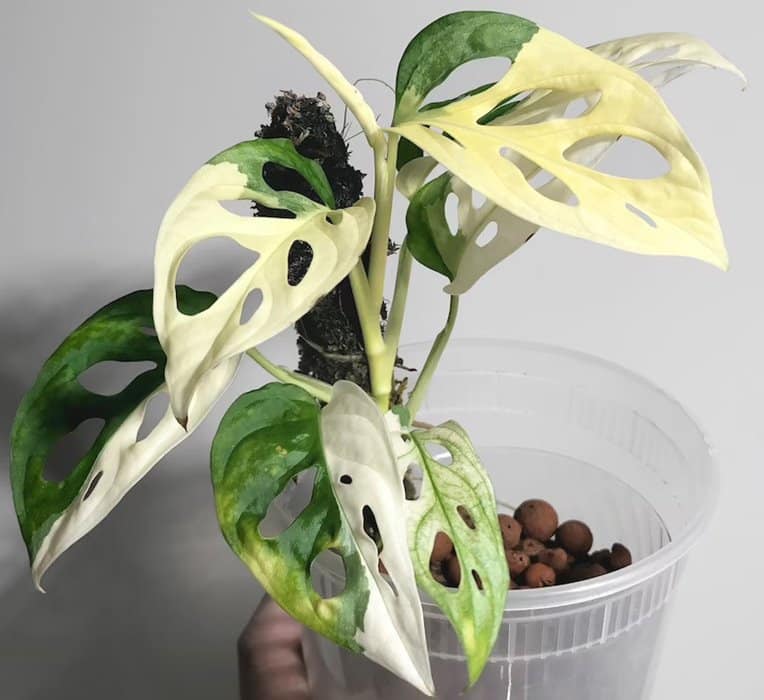
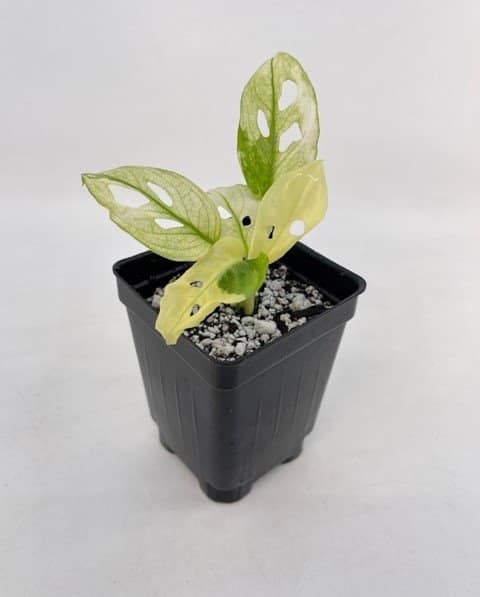
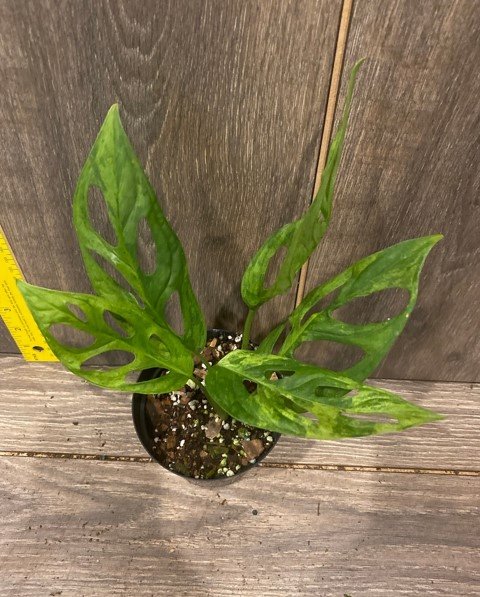

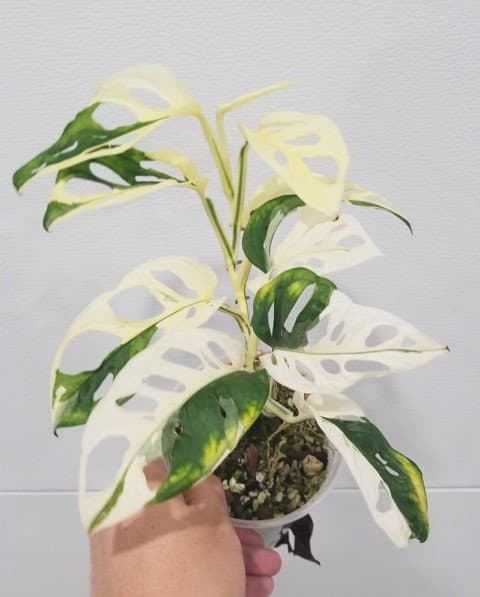
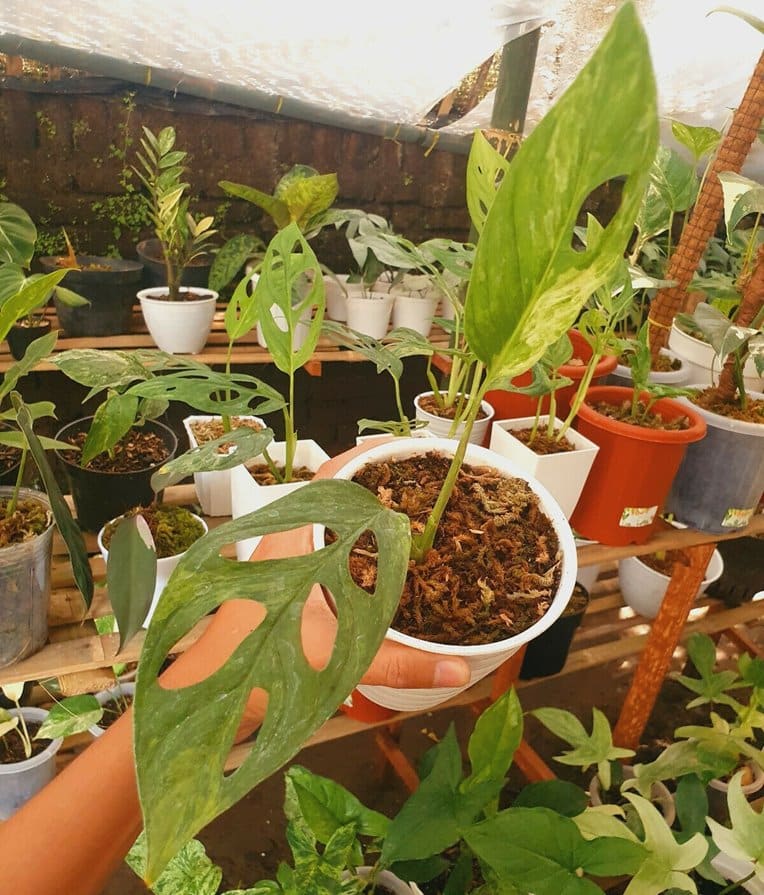
Contents
- About Monstera adansonii
- Quick overview
- Where to grow it?
- Variegated Monstera adansonii care and growth needs
- 1. USDA hardiness zone
- 2. Temperature
- 3. Humidity
- 4. Light
- 5. Soil
- 6. Variegated Monstera adansonii watering
- i. Overwatered
- ii. Underwatered
- 7. Fertilizer
- 8. Pruning and grooming
- 9. Potting and repotting
- Propagation
- i. What you need
- ii. Soil propagation
- ii. Water propagation
- Toxic to pets and humans
- Variegated Monstera adansonii pests
- Diseases and conditions
- 1. Root rot
- 2. Variegated Monstera adansonii yellow leaves
- 3. Curling leaves
- 4. Brown leaves
- Frequently asked questions (FAQs)
About Monstera adansonii
Before we dig deep into Variegated form, it is good to give you some background on this plant. Monstera adansonii is a tropical climbing plant native to central and tropical South America. Also, it occurs on the surrounding islands.
This plant is a member of the arum family Araceae, the so-called aroids. Other popular ornamental aroids are philodendrons, caladium, alocasia, peace lilies, dieffenbachia, pothos, aglaonema, etc.
Monstera adansonii is a complex species with some subspecies, such as M. adansonii var. laniata or blanchetii. In the market, you will commonly find Monstera adansonii narrow and wide forms. But there is also the variegated form, which we are going to cover in detail.
Some Monstera adansonii common names include Adanson’s Monstera, five-hole plant, Swiss cheese vine or plant, and Cheese Swiss philodendron. But in some European countries, it is known as Monstera Monkey Mask. So, if you meet the name Monkey Mask, don’t be surprised.
Last but not least, M. adansonii is the second most popular Monstera, the most popular being Monstera deliciosa. But there are other equally popular species such as M. dubia, M. obliqua, M. siltepecana, etc. Some of these also have variegated forms.
Quick overview
| Scientific name | Monstera adansonii variegata |
| Family | Araceae |
| Common names | Variegated Monstera adansonii |
| Size | About 4 to 8 feet |
| Growth rate | Medium |
| Light requirement | Bright, indirect light |
| USDA hardiness zone | 11b to 12 |
| Temperature | 65°F to 80°F (18 to 27 ºC) |
| Humidity | High humidity (60% to 80%) can it tolerate slightly lower |
| Soil | Chunky, well-drained, and aerated soils that are high in organic matter |
| Watering | Medium, allowing the top 2 to 3 inches of the soil to dry |
| Propagation | Stem cutting in water or soil |
| Toxicity | Toxic to humans, dogs, cats, and other pets |
| Care level | Low or easy to medium |
Where to grow it?
You can grow this lovely plant indoors or outdoors. Just ensure you meet its growing needs. If you want larger leaves, give it a place to climb. A moss pole, burlap-wrapped post, trellis, or bamboo pole will work well. But this is not a must. You can let it cascade on a hanging basket or onto your desktop, shelf, cabinet, and so on.
Variegated Monstera adansonii care and growth needs
The variegated Monstera adansonii care needs are more or less similar to the non-variegated form, such as the narrow or wide form. But you need to ensure your plant has enough light. On this one, don’t compromise. We will tell you why when we look at light needs.
Let us look at the various care needs, including light, humidity, temperature, soil, and much more.
1. USDA hardiness zone
The Monstera adansonii variegata USDA hardiness zone is 11b to 12. This plant cannot tolerate frost. Also, freezing temperatures may kill it. Only people in these zones can grow it outdoors all year. But we don’t see the point of having this lovely rare plant outdoor.
2. Temperature
As a plant from the tropics, it needs a warm place. So, grow your variegated Monstera adansonii in a warm place with optimum temperatures of 65 to 80 degrees Fahrenheit (18 to 27°C).
This plant can tolerate a slightly lower or higher temperature. However, if it goes too low, it will grow slowly. And by the time your temperature is 50°F (10°C), it will stop growing.
That is not all. It would be best if you also avoided sudden dips or spikes in temperatures and cold drafts. Both these two will stress your plant. Therefore, please don’t put it near air condition or room heating vents, draft windows, fireplaces, radiators, and so on.
3. Humidity
Monstera adansonii variegata needs high humidity, about 60 to 80%. But it can still tolerate slightly lower to moderate levels. In low humidity, it may not have lush leaves. Also, it may grow slowly.
If your home has low humidity, mist your plant several times a week or you can use a pebble tray or buy a humidifier. Other ways are grouping your plant to create a microclimate, or you can move your plant room with high moisture levels like your bathroom and kitchen.
However, if your humidity is too low, buy a humidifier. LEVOIT Humidifiers Top Fill, 6 Liter, Cool Mist is a good brand. It runs for up to 60 hours, has a large coverage area, and comes with a Vesync APP. You can use it with Alexa or Google Voice Assistant.
4. Light
Light is one area you must never go wrong. Else, your plant will not have the best variegation coloration. Variegated Monstera adansonii requires bright indirect light.
Compared to the non-variegated form, it needs more light to photosynthesize well since it has lesser chlorophyll. Thus, avoid places with lower lighting. If not, your plant will grow slowly, be leggy, have yellow leaves, and lack proper coloration.
So, if your light is too low, buy a grow light. GE Grow Light LED Flood Light Bulb is an affordable and efficient brand. And to know if your plant is getting enough light, buy Dr. meter LX1330B Digital Illuminance Light Meter. Ideal readings should be between 10,000 and 20,000 lux
On the other hand, avoid direct sunlight as it will scorch leaves. Also, your plant may look bleached, especially in the green areas.
Last but not least, you can have it on an east, west, south, or north-facing window. Just ensure you put it at a distance from the window. Doing so will prevent direct sunlight light from reaching it. But a little early morning or late evening sun is ok.
5. Soil
Like other Monsteras, give your Monstera adansonii variegata chunky, well-drained soil or potting mixes rich in organic matter. Also, they need to be slightly acid, with a pH of 5.5 to 7.5.
Most of the aroid mixes on sale at Etsy.com will work well. But you can also make yours by mixing potting soil, peat moss or coconut coir, and perlite or pumice. Such a mix will retain moisture without being soggy or very wet.
6. Variegated Monstera adansonii watering
These plants are sensitive to overwatering, and it will cause root rot. Also, it would help if you didn’t allow them to be very thirsty.
The best time to water your Monstera adansonii variegated form is after the top 2 to 3 inches or up to first knuckle of your finger feels dry.
We use XLUX Soil Moisture Meter and water when the reading is 3 or below. It is accurate, responds fast and doesn't use batterie.
Under normal home environments, you may have to water this plant every 4 to 7 days in summer and spring and biweekly in the non-growing season or even longer. But this depends on your temperature, humidity, light, pot size, plant size, among other factors.
Lastly, when it is time to water your plant, pour water slowly until you see some coming from drainage holes. After that, discard any that collects on the saucer.
i. Overwatered
Overwatered variegated Monstera adansonii will start having yellow leaves that don’t feel dry. But the soil will be soggy. Also, this Monstera's leaves may droop or wilt, curl, drop, have brown splotches.
When you see a mushy stem base and moldy potting mix, it means your plant has root rot. It would be best if you repotted it to help manage the issue.
Only water this plant when the top few inches of the soil feel dry to fix the issue. Also, have well-draining soil and the right pot size with drainage holes.
ii. Underwatered
When thirsty, your Monstera will start curling leaves upwards. Also, it may have dry brown tips and edges. Also, it will droop, grow slowly, have yellow leaves, and some may start to drop.
Water your plant immediately, have a watering reminder on your phone, and ensure the potting mix holds some moisture.
7. Fertilizer
Variegated Monstera adansonii is a medium feeder. So, feed it about once a month during the growing season only. Use a balanced (N-P-K 20-20-20 or 10-10-10), all-purpose indoor plant food. Even non balanced formula for houseplants are ok.
We use Miracle-Gro Indoor Plant Food (Liquid) and feed after every two weeks. One pump for a small port and two for a large one.
Alternatively, you can go for a slow-release formula. Osmocote Smart-Release Plant Food Plus Outdoor & Indoor is an excellent choice. The application rate is one tablespoon (3 teaspoons) per 192 square inches once in four months.
For instance, for a 6-inch pot (area 28.27 square inches), you will apply about ⅛ of a tablespoon. Work the fertilizer into the soil 1-3 inches deep.
Last but not least, don’t overdo plant foods. Else, your plant may end up with some issues like fertilizer burns.
8. Pruning and grooming
Use a sterilized pruning shear to cut any diseased, dead, or damaged leaves. Also, don't forget to wipe the leaves.
During spring and summer, you can cut some stems to control growth and keep the shape you need. Do this when you intend to propagate this rare plant. You don’t have to throw the branches away.
9. Potting and repotting
Repot this Monstera after every 2 to 3 years or if rootbound, i.e., it has outgrown the pot, and you can see some roots growing from drainage holes. Also, leaves may curl, turn yellow (starting with lower), or start dropping. Other signs are slow growth, leggy plants, and spiraling roots.
Pick a pot 2-3 inches wider in diameter when repotting, and do it when your plants are actively growing.
Propagation
Variegated Monstera adansonii propagation is by stem cutting, and you can use water, soil, or a soilless potting mix. Also, you can propagate this plant by air layering. But it is not possible to grow this variegated plant from seeds.
Wait until early spring to propagate the plant. But summer is also ok but may not give your plant enough time to root well.
The process is more or less what we saw on Monstera adansonii propagation in soil and water. But we will still go over it.
i. What you need
- Jar or nursery pot
- Water or potting mix
- Sterilized pruning knife or shears
- Rooting hormone. While not a must, it will help prevent rotting and boost faster rooting. In my opinion, HydroDynamics Clonex Rooting Gel is the best. It has rooting hormone, nutrients and trace elements.
- Sealable transparent plastic bag. Again, this one is optional. But it will help lock in moisture if you don’t have a humidifier or a greenhouse cabinet.
ii. Soil propagation
You can use well-drained soil, a mixture of perlite and peat moss, or even sphagnum moss alone for soil propagation.
- Pick a mature, healthy stem with at least a node and cut it just below the node with your pruning knife or sheer. If the cutting has more than two leaves, remove the lower leaves.
- Apply your rooting hormone on the cut end – the one you will plant into the soil.
- Make a hole on your potting mix and plant the cutting, ensuring the potting mix covers at least a node. Lightly tamp the soil to ensure the cutting stands upright.
- Water your plant thoroughly until some water comes from the drainage holes. If you use sphagnum moss alone, you will need to soak and wring it before placing it in your nursery pot.
- Cover the plant with your plastic bag and place it in a warm area with bright, indirect light. Please make sure that leaves don’t touch the plastic bag.
- Check after every few days to see if the potting mix is still moist. If dry, you need to mist it lightly. Also, you need to remove the plastic bag for a few hours after a few days to allow your plant to get fresh air.
Your plant will start putting out roots after 3 to 4 weeks. Transplant it when it has a few new leaves.
ii. Water propagation
Water propagation is just the same as soil. But you will put the cutting in a jar with water instead of soil. Just ensure no leaves are submerged. Or else, they will rot. Also, you don’t have to cover it with a plastic bag. Water will help retain humidity as it evaporates.
Please don’t forget to replace it when it is cloudy or add more when the level falls during the propagation period.
Last but not least, this method will allow you to see roots as they grow. Transplant it when the roots are about a few inches long and there is new growth.
Toxic to pets and humans
Variegated Monstera adansonii is harmful or toxic to humans, your dogs, cats, and other pets. All parts of the plant are poisonous.
If ingested, expect severe oral irritation and pain, drooling, and a swollen tongue, mouth, or lips. Other signs are lack of appetite, swallowing difficulties, mouth pawing (in pets), etc.
Kindly keep this plant out of reach of your pets and kids. Also, when handling it, put on your gardening gloves. Why? Because its sap may cause some skin irritation.
Variegated Monstera adansonii pests
Pets are not a common problem to this Monstera, especially if you grow it inside your house. But it can end up with thrips, mealybugs, spider mites, scale insects, or even aphids.
The signs will depend on the bug your plant has. Common ones include honeydew, sooty mold, webbing, speckles, spots (brown, black, or yellowish). Also, a heavy infestation may distort leaves, cause stunted growth or even death.
Always isolate new plants and check for any pests. In case of any bugs, use horticultural oil, neem oil, or insecticidal soaps. Also, you can hose them off or use rubbing alcohol to clean them off the leaves, among other ways.
Diseases and conditions
These Monsteras may get powdery mildew, leaf spot, rusts, anthracnose, root rot, southern blight, or botrytis. But they are not common except root rot.
To help reduce instances of disease, clean your hands before and after touching any of your plants. Also, sterilize your pruning shears and isolate new plants. If diseased, cut off any damaged parts, and in some cases, you have to discard the whole plant.
Let us now look at root rot and common issues your plants may have:
1. Root rot
Overwatering and poorly draining soil is the leading cause of root rot. These two starve oxygen to the roots, making them not work well (absorb water and oxygen well). If prolonged, they will be weak, making it easy for soil fungi and bacteria which multiply in these conditions to attack it.
Common signs of root rot include yellow or brown leaves, wilting, leaf falling, slow growth, and a mushy stem base. Also, the potting mix may turn moldy and have a foul smell.
2. Variegated Monstera adansonii yellow leaves
The most likely cause of yellow leaves in this Monstera adansonii variegata is overwatering. But it may also be underwatering, heat stress, nutrient deficiency, transplant shock, too much feeding, or your plant is rootbound. Other possible causes are too much or too little light, low humidity, diseases, or pests.
Look at what other signs your plant has to help identify the exact reason why leaves are yellowing. In some cases, such as older leaves turning yellow before they die is normal.
3. Curling leaves
If this Monstera is curling leaves, it is a likely sign that your plant is thirsty or needs water. Check if the soil is also dry. Also, the leaves have brown crispy edges and tips.
Besides moisture, anything that leads to more water loss than the roots can absorb or affects absorption is a possible cause. These include too much light, heat stress, low humidity, transplant shock being rootbound, and so on.
4. Brown leaves
Brown, crispy edges and tips indicate low humidity, underwatering, too much light (sunburn), and heat stress. If the leaves have brown spots or splotches, possible causes include pests, overwatering, and diseases.
Frequently asked questions (FAQs)
Variegated Monstera adansonii, including the Archipelago and Mint variegated Indonesia, are rare houseplants. You are unlikely to find them at your local nurseries, specialty, or even big box nurseries. Only a handful of rare plant collectors have this Monstera, and it costs a fortune.
Variegated Monstera adansonii price ranges from $400 to $3000. This cost will depend on where you buy it, its size, and which exact variegated form you are buying. For instance, M. adansonii Variegated Aurea and Mint Variegated Wide Form will cost you $1200 to $3000. Please note that some of these plants are just rooted cuttings with a few leaves.
If you are looking for Monstera adansonii Variegated forms, begin your search at Etsy.com. They have the best prices, and you are likely to get a vendor near you. Furthermore, some will ship to Australia, Canada, the US, or even Europe.
Besides Etsy.com, the next place is eBay. Also, try looking for it on Instagram and some Facebook, plant grounds, especially those for rare plants. As you look for it, be careful as scammers pose to sell this rare plant.
A variegated Monstera adansonii can revert to the normal green leaf due to stress, less light, etc. But it will always remain a variegates. Just give it ideal conditions. It will again start having variegated leaves.
On the other hand, a non-variegated Monstera adansonii can start having variegated leaves. In most instances, this happens because the plant was initially variegated but was not producing variegated leaves.
The other possible scenario is if the plant undergoes a cell mutation. These mutations are what cause the variegation, and they occur randomly but are rare.
No. You cannot. As a variegated plant, it is not possible to propagate it using seeds and have a variegated plant. The mutations only occur in the leaves. Thus, if you need another plant, propagate it by stem cutting.






Aroidsale
Beautiful Plants...
Thank you